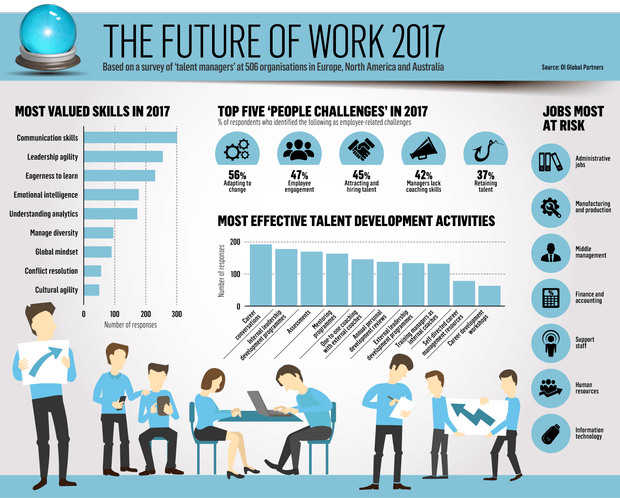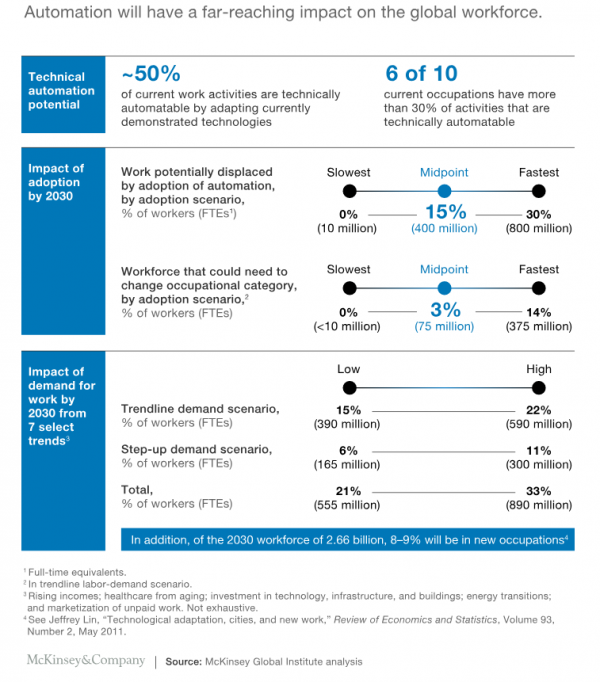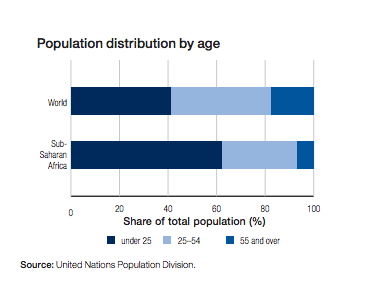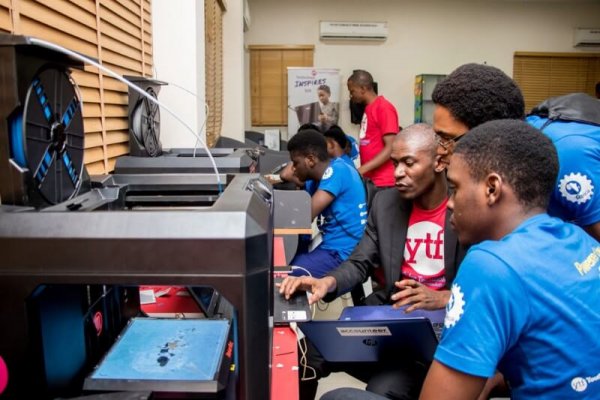The phrase — Future of Work — has been a hot topic since late 2016. Researchers, employers, and policymakers use the phrase to describe the paradigm shift in human resource management as a result of the emerging era of automation, artificial intelligence and robotics. Futurists are concerned about the consequence of automation on the workforce globally.
The Future of Work 2017 Report Src: Independent.ie
Disruption in the workplace culture, model and tools is not a strange phenomenon. The Industrial Revolution, which swept Europe and the New World in the 18th and 19th centuries, disrupted the agriculture and manufacturing industry globally and introduced similar disruptions across sectors. However, unlike the preceding innovations, the expected future of work will empower machines to “work as humans”, “not just for humans”. Artificial intelligence, for instance, will be used to automate customer relationship and deliver bespoke services such as self-driving.
The age of automation raises a renewed demand for humans to learn new skills, whereas current workforce trends require new ways of working. Both factors form the endpoints of the future workforce. Mckinsey Global Institute in 2016 released the Gig Economy report and the “Jobs Lost, Jobs Gained” report the following year. Both reports and other related reports provide empirical insights into the core of the future workforce. This core entails the rise of new specialized skills and a high demand for more flexible ways of working. Jobs requiring physical activities in predictable environments or patterns are likely to decline rapidly. In essence, both work tools and work culture will be transformed drastically.
Researchers anticipate a future of improved productivity and the endless potential of digital technologies. The impact of automation is expected to be massive and revolutionary by 2030 especially in the top global economies such as the US, China, Japan, Germany, UK, and India. However, the impact largely depends on the rate of adoption. By 2050, leading global economies may have fully adopted technical automation considering the pace of prevailing investment in the R&D sector.
There is a growing concern for the future of work in Africa. Policymakers, businesses, and scholars express anxiety for the fate of Africa’s workforce in the next coming decades due to the dearth of reliable workforce dataset and infrastructural deficit. Economic performance indicators in Sub-Saharan Africa in recent time are impressive and optimistic. World Bank reports that Sub-Sahara Africa maintains a gradual, but steady, economic recovery in 2018 at a 3.1% with a projection of 3.6% growth on average in 2019/2020. However, it is interesting to make a comparative analysis of economic growth in Sub-Saharan and its booming population with an emphasis on the region’s workforce. The region’s progressive economic transformation and a growing population boom may face an imminent challenge.
According to the World Economic Forum research findings contained in a report entitled “The Future of Jobs and Skills in Africa”, “Sub-Saharan Africa currently only captures 55% of its human capital potential, compared to a global average of 65%. With more than 60% of its population under the age of 25, Sub-Saharan Africa is the world’s youngest region. By 2030, the continent’s working-age population is set to increase by two-thirds, from 370 million adults in 2010 to over 600 million in 2030.” The research further reveals 52% projected increase by 2030 in the share of the workforce with at least a secondary education, as against 36% in 2010.
Africa has the highest rate of vulnerable employment (defined as self-employment or unpaid family work) globally, remaining at around 66%, according to the International Labour Organization’s 2018 Trends report. The report further suggests that “in 2017, 290 million African workers are estimated to be in vulnerable forms of employment — a figure that is expected to go up by nearly 9 million in 2018, with the largest increase in sub-Saharan Africa.”
The causes of Africa’s unemployment, vulnerable employment rate and unstructured workforce are not far from the obvious. Aside from infrastructural and institutional decadence, there is a significant decline in technical education and vocational training (TVET) as well as a shortage of STEM professionals. According to a GE report, “70% of graduates in Africa have qualifications in the social sciences and humanities — the highest share in the world.” UNDP reported that one in six African college students will graduate with a STEM degree.
According to a WEF, “an estimated 15 to 20 million increasingly well-educated young people are expected to join the African workforce every year for the next three decades.” However, there is a gross disparity between learning in tertiary institutions in Africa and the skills required for the workforce. Employers have expressed dissatisfaction with the quality of graduates introduced into the labor market yearly. Nigeria’s former Vice President once said “Government has noted the skill gaps in the economy and has observed that most of the youths are unemployable. This is a major challenge in the national transformation process that requires the creation of jobs massively for the relevant sectors of the economy.” Subtly put, as Africa’s economy is on the rise, the challenge of unemployment is not unemployment, but lack of employable skills.
There is a huge gap between academic institutions and the enterprise sector in Africa. Tertiary institutions in Africa are yet to fully take up leadership roles in innovations, research & development, and professional training. Until African universities and colleges leapfrog the current moribund system, economic viability in Africa is not in sight.
Enterprise and non-profit sector’s commitment to human capacity building is an essential supplementary approach to conventional education. There is a need for collaboration between businesses and the education sector in addressing the skills gap, as much as the need for businesses to collaborate in building a progressive talent pipeline for the future of the workforce in Africa. 3D Africa HackforGood is an example of such a model for building a talent pipeline while connecting businesses and the education sector.
Youth for Technology Foundation, through the 3D Africa HackforGood platform, is building a talent pipeline in Africa starting in Nigeria. The 3D Africa HackforGood is a DIY model of experimental learning aimed at giving university students and young innovators a launch pad for creating solutions to national problems. First hosted at the Chukwu Odimegwu Ojukwu University (COOU) in Anambra State, Nigeria in 2017, the design and prototyping challenge has directly empowered 75 (25 in 2017 and 50 in 2018) young Nigerians to create solutions to specific community problems leveraging emerging technologies such as 3D printing, artificial intelligence, internet of things, blockchain, machine learning and virtual reality. This infographic shows the summary of HackforGood launchpad.
HackforGood 2018
Youth for Technology Foundation doubled the effort in 2018 at the University of Lagos (UNILAG) with 100% more hackers, 8 teams and more private sector partners including Microsoft, CocaCola, HP, and Uber. HackforGood provides its participants with the opportunity to leverage cutting-edge technology, training, and mentoring to develop a functional prototype that addresses the real-world needs of their communities, transforming their mindset from “Aid to Africa to Made in Africa”, according to Njideka Harry during the launch of 3D Africa in 2015. The participants are provided with ongoing platform support and resources to grow their ideas to a sustainable market-fit solution.
The HackforGood model may not be a fix-it-all framework for solving Africa’s skill gap challenge. However, it is a bespoke model aimed at bridging the gap between institutions of higher learning and businesses while providing students and young graduates with problem-solving skills required for the future of work in Africa.
Blessed with considerably untapped human capital, Africa’s economic prosperity or social instability largely depends on what becomes of its youths. It is imperative that both the private and public sectors invest in building not just skills, but a talent pipeline with future skills. Laying a foundation for Africa’s current and future workforce requires a deliberate policy approach, private sector commitment, and institutional reforms.
Article by: Joseph Ibeh
Source: Medium





